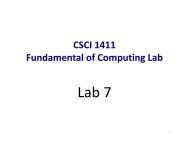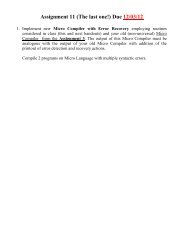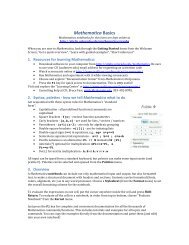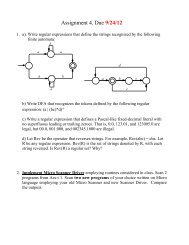[PDF] The Thickness and Chromatic Number of r - Gammeter.com
[PDF] The Thickness and Chromatic Number of r - Gammeter.com
[PDF] The Thickness and Chromatic Number of r - Gammeter.com
You also want an ePaper? Increase the reach of your titles
YUMPU automatically turns print PDFs into web optimized ePapers that Google loves.
u2 v2 w2<br />
✉ ✉ ✉<br />
� ����<br />
� ����<br />
✉ ✉ ✉<br />
u1 v1 w1<br />
✁ ✁✁✁✁✁✁✁✁✁✁✁✁✁✁<br />
❆<br />
❆<br />
❆<br />
❆<br />
❆<br />
❆<br />
❆<br />
❆<br />
❆<br />
❆<br />
❆<br />
❆<br />
❆<br />
❆<br />
✡ ❆<br />
✡✡✡✡✡✡✡✡✡✡<br />
❏<br />
❏<br />
❏<br />
❏<br />
❏<br />
❏<br />
❏<br />
❏<br />
❏<br />
❏<br />
✱ ❏<br />
✱✱✱✱✱✱✱<br />
✟ ✟✟✟✟✟✟✟<br />
u1<br />
✉<br />
✉<br />
u2<br />
w1 ✉<br />
❧<br />
❧<br />
❧<br />
❍<br />
✉ ❧<br />
w2 ❍<br />
❍ ❧<br />
❍<br />
❍❧<br />
❍❧<br />
✉<br />
❍<br />
❧❍<br />
✉<br />
v1<br />
v2<br />
Figure 1: Two plane drawings <strong>of</strong> the clone <strong>of</strong> P3.<br />
Example 1. Let P3 be the path <strong>of</strong> length two with vertices labeled u, v, w in linear<br />
order. Denote the vertices <strong>of</strong> the clone <strong>of</strong> P3 by u1, u2, v1, v2, w1, w2. Two plane<br />
drawings <strong>of</strong> the clone <strong>of</strong> P3 are given in Figure 1.<br />
<strong>The</strong> righth<strong>and</strong> drawing in Figure 1, a straightline drawing given by nesting nonconvex<br />
K4s, helps to illustrate the inductive argument that we will use below.<br />
<strong>The</strong>orem 1. If T is a tree, then its clone is planar.<br />
Pro<strong>of</strong>. If T is a single edge, then its clone is K4, which is planar. Let T be a tree with<br />
at least two vertices <strong>and</strong> assume that all trees on fewer vertices than T are planar<br />
when cloned. Let w be a leaf <strong>of</strong> T with neighbor v. Let w1, w2 <strong>and</strong> v1, v2 be the<br />
vertices <strong>of</strong> T [2] associated with vertices w <strong>and</strong> v. Prune w from T , yielding tree T ′ .<br />
Since T ′ has fewer vertices than T , its clone is planar by the inductive hypothesis.<br />
<strong>The</strong> distinction between T ′ [2] <strong>and</strong> T [2] is that T ′ [2] is missing vertices w1, w2, the<br />
edge between them, <strong>and</strong> the edges between them <strong>and</strong> v1, v2. We wish to add these<br />
vertices <strong>and</strong> edges to T ′ [2] without adding any crossings. Take a straightline plane<br />
drawing <strong>of</strong> T ′ [2] <strong>and</strong> note that the (straightline) edge between v1 <strong>and</strong> v2 bounds two<br />
faces <strong>of</strong> T ′ 2. Add vertices w1, w2 to one <strong>of</strong> these faces so that they create a non-convex<br />
set with v1, v2. We can now add the remaining edges among v1, v2, w1, w2 without<br />
introducing crossings. Thus we have a plane drawing <strong>of</strong> T [2].<br />
<strong>The</strong> planarity <strong>of</strong> the clone <strong>of</strong> a tree is a useful tool for bounding the thickness <strong>of</strong><br />
a cloned graph by using the arboricity <strong>of</strong> the original graph.<br />
<strong>The</strong>orem 2. If G has arboricity k, then G[2] has thickness at most k.<br />
4


![[PDF] The Thickness and Chromatic Number of r - Gammeter.com](https://img.yumpu.com/3978766/4/500x640/pdf-the-thickness-and-chromatic-number-of-r-gammetercom.jpg)





